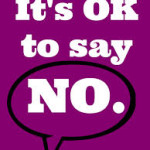 At dinner last night, a friend who had the good fortune of being at Woodstock relayed a story shared by Arlo Guthrie. Guthrie was at Woodstock and was asked to play a day before he was scheduled to appear. While uncomfortable with the request for a number of reasons one might guess, he went on to play at the earlier time. A couple of years later in an interview he shared that he could of and should of just should said, “No – I’m scheduled to perform tomorrow.”
At dinner last night, a friend who had the good fortune of being at Woodstock relayed a story shared by Arlo Guthrie. Guthrie was at Woodstock and was asked to play a day before he was scheduled to appear. While uncomfortable with the request for a number of reasons one might guess, he went on to play at the earlier time. A couple of years later in an interview he shared that he could of and should of just should said, “No – I’m scheduled to perform tomorrow.”
This story led us to talking about “no” and how uncomfortable people are saying “no.” For many, “no” is one of the most difficult words to include in a conversation or business discussion.
We’re afraid if we say “no” we’re going to ruin a relationship,” says William Ury, co-founder of Harvard’s Program on Negotiation and author of Getting to Yes with Yourself and Other Worthy Opponents. So, how can saying “no” or disagreeing with a customer become a positive?
Although the context for Ury’s article was business conversations in general, we thought the points were particularly useful for salespeople. So we translated the ideas to the world of Sales and added a few of our own. Let’s take a look at when and how to say “no”:
- It brings value to the customer. Don’t be afraid to say “no” or disagree. Sometimes not giving into a customer’s demands or accepting their point of view can reflect that you’re interested in what’s best for them, as well as, being in your self-interest. It becomes a launching platform for sharing expertise that brings value to the customer. Let’s explore a couple of specific sales scenarios as cases in point. The customer often has a history with you and therefore they know a lot about your capabilities. But anyone making a judgment about a particular capability may have less than a complete assessment. It is important to find out the customer’s view of your competence on that capability. If that view is not objectively accurate, then finding a way to correct the misperception is both important for the customer and for you.
A second example is when a customer has deemed a particular specification for comparing competitive options to be extremely important and in your experience that priority is misplaced. If a customer would end up making a better decision if the predetermined importance was different, then helping them to change their point of view brings value to the customer and that is appropriate. Obviously, it is not appropriate if the viewpoint shift is strictly in your self-interest.
- Say “no” but don’t close the door. This means that while you’re saying “no” to one request, you don’t close the door on continuing the relationship. Ury notes: “There’s a no that’s matter of fact, respectful, and that can lead to a yes on the other side.”
For example, during a scope of work discussion, a salesperson might say – “No, getting the deliverable finished a month sooner is not within the scope of the present project but if we had the following resources that could be achieved – do you think that is a viable trade-off for you?” or “No, although we were both pleased with the results of the training project we did, we do not have the expertise to install a new CRM system, but I could recommend someone that we feel would meet your requirements.”
- Don’t play games with “no”. Some say no a customer request to appear more desirable to the customer or to justify a higher cost – “We are just so busy right now we couldn’t start the project for at least another month.” Even if you win in the short run, the gaming idea is not a long a good long-term strategy.
- Remember it is a skill. Saying “no” is a skill, so practice. You just can’t say “yes” and agree to everything – you will run out of “time and tape.” If you’re not comfortable saying “no”, then raise your comfort level by practicing. It’s the only way to get better at any skill.
While saying “no” isn’t easy for most people – and certainly difficult for salespeople when working with their customers, it can form the basis of better business relationships – leading to better solutions for you and for the customer … and ultimately leading to you and the customer finding opportunities to say “yes”.
This article was syndicated from Business 2 Community: Sales reps – how to bring value by saying “no”
More Sales & Marketing articles from Business 2 Community:




